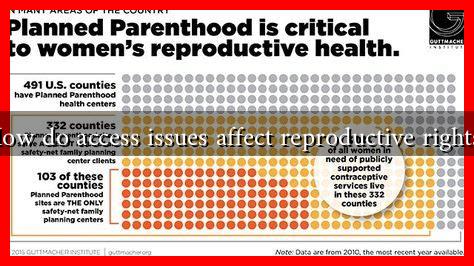-
Table of Contents
How Do Access Issues Affect Reproductive Rights?
Reproductive rights encompass a broad range of issues, including access to contraception, abortion services, and comprehensive sex education. However, access issues significantly hinder individuals’ ability to exercise these rights. This article explores how various barriers—geographical, financial, and systemic—impact reproductive rights and the implications for individuals and society as a whole.
The Landscape of Reproductive Rights
Reproductive rights are recognized as fundamental human rights by various international organizations, including the United Nations. However, the reality on the ground often tells a different story. Access to reproductive health services varies widely across different regions and demographics, leading to significant disparities in health outcomes.
Geographical Barriers to Access
One of the most significant access issues affecting reproductive rights is geographical location. In many rural and underserved urban areas, reproductive health services are scarce. This can lead to a range of negative outcomes, including:
- Limited Availability of Clinics: Many rural areas lack clinics that provide essential reproductive health services, including family planning and abortion services.
- Transportation Challenges: Individuals may need to travel long distances to access services, which can be prohibitively expensive and time-consuming.
- Provider Shortages: A lack of trained healthcare providers in certain areas can limit the availability of reproductive health services.
For example, a study by the Guttmacher Institute found that nearly 90% of U.S. counties without an abortion provider are rural, highlighting the geographical disparities in access to reproductive health services.
Financial Barriers to Access
Financial constraints also play a critical role in limiting access to reproductive health services. The costs associated with contraception, abortion, and related healthcare can be significant, particularly for low-income individuals. Key financial barriers include:
- High Costs of Services: Many individuals cannot afford the out-of-pocket costs for reproductive health services, especially in areas where insurance coverage is limited.
- Lack of Insurance Coverage: Some insurance plans do not cover reproductive health services, making them financially inaccessible for many.
- Transportation and Childcare Costs: The financial burden of traveling to a clinic and arranging for childcare can deter individuals from seeking necessary services.
According to the National Women’s Law Center, nearly 1 in 4 women of reproductive age in the U.S. live in a state that has enacted laws restricting access to abortion, often leading to increased costs and logistical challenges.
Systemic Barriers and Policy Implications
Systemic issues, including discriminatory policies and social stigma, further complicate access to reproductive rights. These barriers can manifest in various ways:
- Restrictive Legislation: Many states have enacted laws that impose waiting periods, mandatory counseling, and other restrictions that complicate access to abortion services.
- Stigmatization of Reproductive Health Services: Social stigma surrounding reproductive health can discourage individuals from seeking care or discussing their needs with healthcare providers.
- Inadequate Education: A lack of comprehensive sex education can lead to misinformation about reproductive health, further complicating access to necessary services.
For instance, the recent Supreme Court decision in Dobbs v. Jackson Women’s Health Organization has led to a wave of restrictive abortion laws across the U.S., significantly impacting access for millions of individuals.
Case Studies and Real-World Impacts
Several case studies illustrate the real-world implications of access issues on reproductive rights:
- Texas: Following the implementation of Senate Bill 8, which effectively banned most abortions after six weeks, many individuals have been forced to travel out of state for care, incurring significant costs and logistical challenges.
- Mississippi: The closure of clinics due to restrictive laws has left many individuals without access to essential reproductive health services, leading to increased rates of unintended pregnancies and maternal health complications.
Conclusion
Access issues significantly affect reproductive rights, creating barriers that can have profound implications for individuals and society. Geographical, financial, and systemic barriers all contribute to disparities in access to reproductive health services. Addressing these issues requires comprehensive policy changes, increased funding for reproductive health services, and a commitment to dismantling the stigma surrounding reproductive health. Only by ensuring equitable access can we uphold the reproductive rights of all individuals.
For more information on reproductive rights and access issues, visit the Guttmacher Institute.

